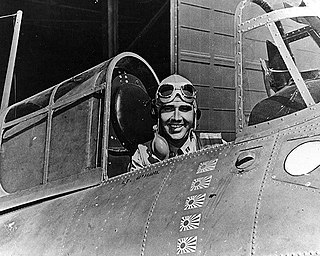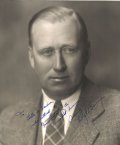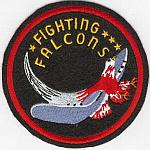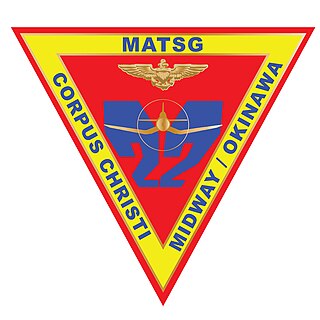
Joseph Jacob Foss was a United States Marine Corps Major and a leading Marine fighter ace in World War II. He received the Medal of Honor in recognition of his role in air combat during the Guadalcanal Campaign. In postwar years, he was an Air National Guard Brigadier General, served as the 20th Governor of South Dakota (1955–1959), president of the National Rifle Association of America (NRA) and the first commissioner of the American Football League. He also was a television broadcaster.

Lieutenant Commander Edward Henry O'Hare was an American naval aviator of the United States Navy, who on February 20, 1942, became the Navy's first fighter ace of the war when he single-handedly attacked a formation of nine medium bombers approaching his aircraft carrier. Even though he had a limited amount of ammunition, he was credited with shooting down five enemy bombers and became the first naval aviator recipient of the Medal of Honor in World War II.

The Grumman TBF Avenger is an American World War II-era torpedo bomber developed initially for the United States Navy and Marine Corps, and eventually used by several air and naval aviation services around the world.

The Grumman F4F Wildcat is an American carrier-based fighter aircraft that entered service in 1940 with the United States Navy, and the British Royal Navy where it was initially known as the Martlet. First used by the British in the North Atlantic, the Wildcat was the only effective fighter available to the United States Navy and Marine Corps in the Pacific Theater during the early part of the Second World War. The disappointing Brewster Buffalo was withdrawn in favor of the Wildcat and replaced as aircraft became available.

The Grumman F6F Hellcat is an American carrier-based fighter aircraft of World War II. Designed to replace the earlier F4F Wildcat and to counter the Japanese Mitsubishi A6M Zero, it was the United States Navy's dominant fighter in the second half of the Pacific War. In gaining that role, it prevailed over its faster competitor, the Vought F4U Corsair, which initially had problems with visibility and carrier landings.

Henry Talmage "Hammerin' Hank" Elrod was a US Marine Corps aviator. He was the first aviator to receive the Medal of Honor during World War II, for his heroism in the defense of Wake Island.

The Air Force Cross (AFC) is the United States Air Force and United States Space Force's second highest military decoration for airmen and guardians who distinguish themselves with extraordinary heroism in combat with an armed enemy force. The medal is awarded to any person, while serving in any capacity with the Air Force or Space Force, who distinguish themselves by heroism which is extraordinary but not sufficient for the award of a Medal of Honor.

Leroy Randle "Roy" Grumman was an American aeronautical engineer, test pilot, and industrialist. In 1929, he co-founded Grumman Aircraft Engineering Co., later renamed Grumman Aerospace Corporation, and now part of Northrop Grumman.

A folding wing is a wing configuration design feature of aircraft to save space and is typical of carrier-based aircraft that operate from the limited deck space of aircraft carriers. The folding allows the aircraft to occupy less space in a confined hangar because the folded wing normally rises over the fuselage decreasing the floor area of the aircraft. Vertical clearance is also limited in aircraft carrier hangar decks. In order to accommodate for this, some aircraft such as the Supermarine Seafire and Fairey Gannet have additional hinges to fold the wingtips downward, while others such as the A-5 Vigilante and S-3 Viking have folding tails. The F-14 Tomcat's variable-sweep wings could be "overswept" to occupy less space.

Marine Fighter Attack Squadron 211 (VMFA-211) is a United States Marine Corps fighter attack squadron, currently consisting of F-35B Lightning II stealth STOVL strike fighter jets. Known as the "Wake Island Avengers" and the "Bastion Defenders", the squadron is based at Marine Corps Air Station Yuma, Arizona and falls under the command of Marine Aircraft Group 13 (MAG-13) and the 3rd Marine Aircraft Wing.
John Bennett Nichols III was a United States Navy aviator and author.

George Andrew Davis Jr. was a highly decorated fighter pilot and flying ace of the United States Army Air Forces in World War II, and later of the United States Air Force during the Korean War. He was killed in action during a combat mission in northwestern Korea, in an area nicknamed "MiG Alley". For his actions during the Korean War, Davis was posthumously awarded the Medal of Honor and promoted from major to lieutenant colonel.
Henry Barrett Tillman is an American author who specializes in naval and aviation topics in addition to fiction and technical writing.

Marine Fighting Squadron 221 (VMF-221) was a reserve fighter squadron of the United States Marine Corps. Originally commissioned during the World War II, it flew the Brewster F2A-3, and after reconstitution in 1943, the F4U Corsair. The squadron, also known as the "Fighting Falcons", is most notable for its actions on 4 June 1942, during the Battle of Midway, which resulted in 23 members of the squadron, many posthumously, being awarded the Navy Cross for their actions in combat. VMF-221 ended World War II with 185 air-to-air victories, the second most of any Marine Fighting Squadron in the war.

Charles Joseph Loring Jr. was a fighter pilot in the United States Army Air Forces in World War II, and later in the United States Air Force in the Korean War. Loring rose to the rank of major and posthumously received the Medal of Honor for his heroic actions on November 22, 1952, above Kunwha, Korea during a close air support mission.

Louis Joseph "Lou" Sebille was a fighter pilot in the United States Army Air Forces during World War II and later the United States Air Force during the Korean War. He rose to the rank of major and posthumously received the Medal of Honor for his heroic actions on August 5, 1950, in South Korea during the Battle of Pusan Perimeter.

John Springer Walmsley Jr. was a bomber pilot in the United States Army Air Forces after World War II and the United States Air Force during the Korean War. Walmsley rose to the rank of captain and posthumously received the Medal of Honor for his heroic actions on September 14, 1951, above Yangdok, North Korea during a bombing mission.

Marine Aviation Training Support Group 22 (MATSG-22) is a United States Marine Corps aviation training group that was originally established during World War II as Marine Aircraft Group 22 (MAG-22). Squadrons from MAG-22, were decimated at the Battle of Midway and, after reconstituting, fought during the Battle of Okinawa. The group was deactivated following the end of the war and was not reactivated until 1 May 2000, when the Marine Aviation Detachment at Naval Air Station Corpus Christi, Texas was renamed MATSG-22.

Richard C. Mangrum was a United States Marine Corps lieutenant general who served as Assistant Commandant of the Marine Corps from 1965 to 1967. Mangrum was a Marine Corps aviator who was awarded the Navy Cross and the Distinguished Flying Cross for his actions during the Guadalcanal Campaign in World War II.
















